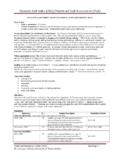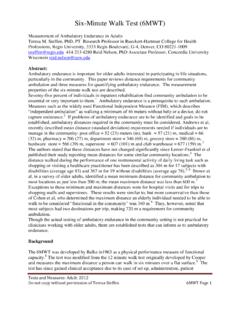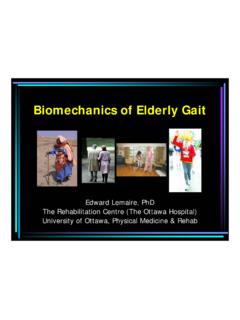Transcription of ACTIVITIES-SPECIFIC BALANCE CONFIDENCE (ABC) …
1 ACTIVITIES-SPECIFIC BALANCE CONFIDENCE (ABC) SCALE Test and Measures: Adult 2012 Do not copy without permission of Teresa Steffen ABC Page 1 Type of test: Time to administer: 5-10 minutes to administer. Clinical Comments: This test, along with a functional BALANCE test, such as the Berg, will tell the clinician if their client is over confident or under confident about falling . Purpose/population for which tool was developed: The ABC is one of several tools designed to measure an individual s CONFIDENCE in his/her ability to perform daily activities without falling .
2 These tools were designed for use with older adults. The ABC was designed to include a wider continuum of activity difficulty and more detailed item descriptors than the Falls Efficacy Scale (FES) (see Appendix 2)1 Fear of falling is important to assess because it is a likely confound in measuring postural performance. Deterioration in BALANCE may result from activity restriction mediated by the fear of When appropriate to use: Asking a yes/no question on fear of falling ( , are you fearful of falling ?) may indicate when the full scale should be used.
3 This may work better for females than The internal consistency does not decrease appreciably with the deletion of a few items; (12 of 16 are necessary). If fewer items are used, compute a total score by dividing by the number of items answered. Scaling: Ordinal. Scale has 16 items (score 0-1600 possible). The score is recorded as a percentage (%), with 100% the highest level of CONFIDENCE . Max score of 1600 divided by 16 items = 100% Equipment needed: Questionnaire (Appendix 1) and pencil Directions: See appendix 1. The authors do not state what to do if the client says that it is an activity they never do.
4 The questions are arranged in a hierarchical order yet this may not be true for all clients. Reliability: The ABC demonstrates a high level of internal consistency. Reference N= Sample Description Reliability Statistic Internal Consistency: (how the items in the scale relate to each other and to the group of items as a whole). Reliability statistic= Chronbach s alpha ( ) Powell, 19951 60 Seniors living at home over 65 years old. = .96 Steffen, 20053 87 community-dwelling seniors .93 Huang, 20094 168 Community dwelling, less frail , >60 in Taiwan Baseline: 8 weeks: Talley, 20085 213 Older woman at risk of falling at baseline and 12 weeks Salbach, 20066 51 People with stroke ABC-French Canadian version =.
5 94 .93 Cattaneo, 20077 20 Multiple Sclerosis Peretz, 20068 157 Parkinson s patients and patients with high level gait disorders (HLGD) with ABC scale and modified ABC-6 scale; HLGD N=70, controls N=68, PD N=19. ABC-HLGD = .90 ABC-Control = .83 ABC-PD = .91 ABC 6-HLGD = .81 ABC 6-Contol = .86 ABC 6-PD = .90 ACTIVITIES-SPECIFIC BALANCE CONFIDENCE (ABC) SCALE Test and Measures: Adult 2012 Do not copy without permission of Teresa Steffen ABC Page 2 Test Retest Reliability: Test retest reliability varied with the ABC from to The MDC was more divergent with the highest MDC = 38% change and the lowest was 13%.
6 Reference Population N X [SD] (time one) Time Between Testing Test/Retest Reliability MDC95 Holbein-Jenny, 20059 Personal care home residents; Age Range74-92 26 1-2 weeks ICC (1,1) = Miller, 200310 Patients from outpatient clinic 50 4 weeks ICC (3,1) = Parry, 2001 (UK ABC)11 Consecutive, ambulant, new, and return patients (n=119) and their friends and relatives (n=74) 39 1 week ICC = Powell, 19951 Steffen,200812 Cattaneo, 20077 Community dwelling older adults; Age: 65-95 Community dwelling adults with Parkinsonism Multiple Sclerosis 21 36 20 70(19) 57(25) 2 weeks.
7 1 week 3 days r = ; ICC(2,1)= ICC(2,1) = 13% 20% Validity: Although there often is no gold standard to measure the ABC against, the ABC is correlated with other self-administered tests and demonstrates Bandura s work on self-efficacy that perceived capability rather than actual physical ability is more predictive of behavior in a given domain . Clinical application of this would include working on the patient s CONFIDENCE in their BALANCE as well as objective BALANCE activities . Construct / Concurrent Validity: It is difficult to always differentiate between these 2 types of validity.
8 Evaluating this property requires a gold standard measure with which to compare the tests results. Such a gold standard is often not available. Population N = Support for Validity Young and older women 34 Young Unimpaired =12 Older Unimpaired = 12 Older Impaired = 10 Correlations between ABC and maximal strength (.75), rapid step test ( ).13 Seniors over 65 60 ABC is correlated with FES ( ), Physical Self-Efficacy Scale Scores (.49), PANAS scale (.12)1, walking speed (.56) and FES ( ).2 Pts with hip fx 56 There is no correlation between changes in FIM scores and change in ABC scores for 56 patients in a specialized rehabilitation The Falls-Efficacy Scale (FES) and ABC were not correlated in this population.
9 Pts in a BALANCE and vestibular clinic 71 Correlation between dizziness handicap inventory (DHI) and ABC (age 26-88) was Mild BALANCE impairment 177 184 ABC correlated with tandem stance time, unipedal stance time, tandem walking, TUG, 6 MWT, Tinneti s Performance Oriented Mobility Assessment (. ).16 Patients with stooping, crouching, and kneeling (SCK) difficulties, characteristics associated with SCK included ABC Scale score. (OR= ; 95% CI, ).17 Community dwelling elderly 50 ABC correlated with BBS (.75) and TUG (.70).18 (Mean age = 82) ACTIVITIES-SPECIFIC BALANCE CONFIDENCE (ABC) SCALE Test and Measures: Adult 2012 Do not copy without permission of Teresa Steffen ABC Page 3 Vestibular dysfunction 137 32 ABC with DGI =.
10 58. This relationship increases for those with mild to moderate vestibular weakness and decreases for those with severe or total vestibular (Mean age = 61) ABC not correlated with Four Square Step Test (FSST)20 4-month follow-up of hip fx pts. 73 ABC correlated with BBS (.77), FES (.68), Gait Speed (.65), Modified Barthel (.67).21 Community dwelling women 65-75 yrs of age 140 ABC with Simple & Complex walking while talking test (WWT) ( & )22 Community swelling >60 yr old seniors in Taiwan 168 ABC with FES baseline/8weeks (.88/.89) Geriatric Rear of falling (GFFM) ( )4 Ambulatory adults with a wide range of BALANCE function first session n=12 second session n=11 ABC with BESTest (.)










